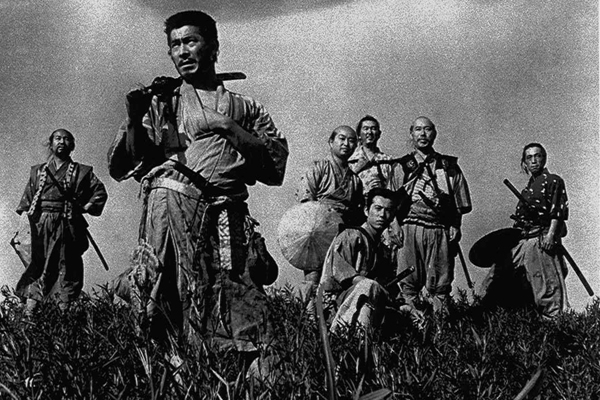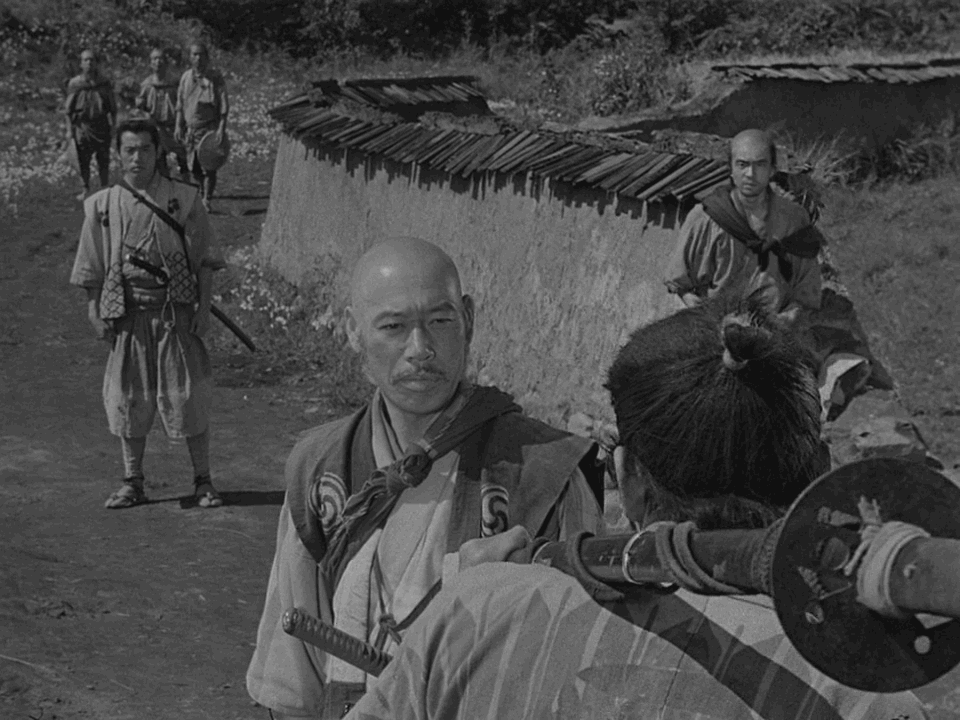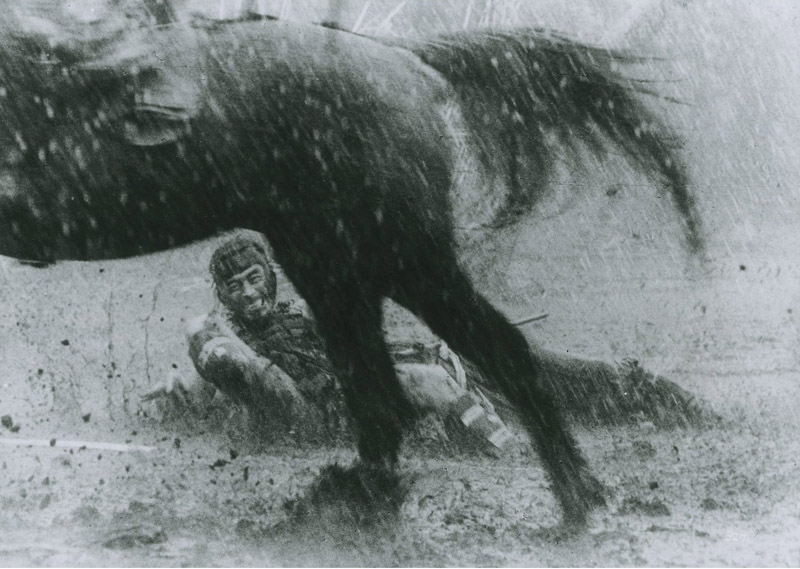Roger Ebert – Great Movie Review – 2001:
A farming community learns that the upcoming harvest will result in a raid by a group of thieving bandits. An outspoken worker suggests that they should go to the nearest town and find a group of warriors who will protect them and help them defend their land…
Wait a second, I think I accidentally put A Bug’s Life into the DVD player instead of Seven Samurai… Sorry about that, I’m always getting those two confused. Obviously, I’m not saying that A Bug’s Life is a remake of Seven Samurai, but there is no doubt that it borrows some of its basis for a story on this original ensemble battle film, as did:
 The Guns of Navarone (1961)
The Guns of Navarone (1961)
The Magnificent Seven (1960)
The Good, The Bad, and The Ugly (1966)
Bonnie and Clyde (1967)
The Dirty Dozen (1967)
The Wild Bunch (1969)
Close Encounters of the Third Kind (1977)
Battle Beyond the Stars (1980)
The Road Warrior (1982)
Die Hard (1988)
Ronin (1998)
Saving Private Ryan (1998)
The 13th Warrior (1999)
The Phantom Menace (1999)
Three Kings (1999)
Ocean’s Eleven (2001)
The Inglorious Bastards (2009)
Clearly, this Akira Kurosawa masterpiece tapped into a concept or trope that was so simple it could be the basis for kids movies, westerns, and space comedies. It is the universal desire to see the strong protect the weak and the fact that with a varied group of warriors, we can each find our own place in the story. But just because Kurosawa did it first, does that necessarily mean that this movie is great? Why has this 3 hour and 27 minute epic held the attention of the cinematic community for over 60 years. Why is this movie regarded as highly as it is? Well, let’s recount the basics of the story’s theme along with some character analysis, then we’ll look at Kurosawa’s skill as a director which I believe sheds some light on what makes this film shine after 60 years of imitators have tried to recreate its charm, power, and craftsmanship.
Seven Samurai takes place in 16th century feudal Japan, primarily in a poor farming village. When a farmer happens to overhear that a gang of bandits plan to raid the village after their harvest, there is a huge uproar and the village is consumed with despair. They eventually decide to travel to a nearby city to find some samurai to assist them. Bit by bit a team is assembled, until they travel back to the village and prepare for the upcoming raid.
 The depth of the movie is not done justice by this concise plot summary, though. The movie really explores several themes very well. We can certainly relate to the theme of combat in our world torn apart by war. At first when we are introduced to the samurai in the movie, they are these impressive, noble figures. But as the movie goes on, we get a closer look at them and see who they really are. Through these stories, we learn that being a hero isn’t something to emulate, because in the end all you’re left with are memories of loss and pain and you can never really be a part of the celebration. Your existence is just being involved in one conflict to the next until the day you die. (Perhaps we should screen this movie for our military leaders?)
The depth of the movie is not done justice by this concise plot summary, though. The movie really explores several themes very well. We can certainly relate to the theme of combat in our world torn apart by war. At first when we are introduced to the samurai in the movie, they are these impressive, noble figures. But as the movie goes on, we get a closer look at them and see who they really are. Through these stories, we learn that being a hero isn’t something to emulate, because in the end all you’re left with are memories of loss and pain and you can never really be a part of the celebration. Your existence is just being involved in one conflict to the next until the day you die. (Perhaps we should screen this movie for our military leaders?)
The film also examines class roles during feudal Japan. The peasant farmers were not allowed to speak to the Ronin (Masterless Samurai) and they would have felt no compulsion to help. Kurosawa doesn’t make it any easy task to assemble this group, in fact we are shown several failures where they farmers are ridiculed and chided for being disrespectful. This film isn’t an illusion, a glossed over fantasy of times long past, it is a realistic, warts-and-all portrayal of people in a severely classist time. What hero of this period would care about a group of farmers when he has lords and castles to protect?
 Enter Takashi Shimura as Kambei, a calm, strategic ronin who admits up front that most of his past battles were losses. He’s introduced to us as he impersonates a priest by shaving his head, and uses charm and deception instead of fierce swordplay to free a hostage. This is a man who cares little for tradition and titles, just doing whatever it takes to save those who need saving, making him a strikingly modern hero in a period often packed with stereotypes. Kambei commits to helping the farmers out of a sense of honor and he begins to strategize and determines that seven samurai will be needed to win this battle. We are introduced to the other members of the team through their interaction with Kambei. I’ve put the names in bold with the character’s description for easy reference.
Enter Takashi Shimura as Kambei, a calm, strategic ronin who admits up front that most of his past battles were losses. He’s introduced to us as he impersonates a priest by shaving his head, and uses charm and deception instead of fierce swordplay to free a hostage. This is a man who cares little for tradition and titles, just doing whatever it takes to save those who need saving, making him a strikingly modern hero in a period often packed with stereotypes. Kambei commits to helping the farmers out of a sense of honor and he begins to strategize and determines that seven samurai will be needed to win this battle. We are introduced to the other members of the team through their interaction with Kambei. I’ve put the names in bold with the character’s description for easy reference.
I’d say there’s only one stereotypical samurai in the entire piece: Kyozo, a stoic master swordsman who spends most of his free time either in quiet contemplation or honing of his technique. The others are a more colorful bunch: Gorobei, a friendly and cheerful archer and military strategist; Heihachi, a mediocre swordsman with a blunt sense of humor that helps to rallies the others; Shichiroji, a former Lieutenant under Kambei who openly laughs that he survived a major battle because he hid in the weeds; Katsushiro, a young man of wealth with a lot to learn, but an eagerness to do so which wins him the opportunity.
And then we get to the man known as Kikuchiyo, played by the delightful Toshiro Mifune. He is not a Samurai at all. He is a poser, born a farmer, yet was orphaned in bandit raids making him sympathetic to the current farmers plight. He is brash, arrogant, and has a desperation for attention which leads to frequent overcompensation (just look at the size of his sword). He is caught between two castes, but he is unwilling to live the life he was born into and wishes to lift himself out of a meaningless existence.
If I could magically allow all current directors to learn one thing from this film it would be the art of character development. At 3 hours and 27 minutes, this film is one of the longest I have ever seen, yet there are no dull spots that seem superfluous. This is because the film excels at fully realizing each character so we are invested in the story.
However, the story isn’t just about the samurai setting up a defense around the town, but about winning over the village’s trust. When the warriors first arrive, they are met not with joy or gratitude, but with fear. These farmers have long memories and they won’t forget the wars that spilled over onto their lands and the atrocities committed by samurai and bandit alike.  It doesn’t help when a cache of armor and weapons stolen from dead (or murdered) samurai turns up. It is interesting that Kurosawa brings the heroes to defend people they don’t trust, and the people have hired heroes they fear. But all must be pushed aside when the harvest arrives and the bandits make their grand entrance.
It doesn’t help when a cache of armor and weapons stolen from dead (or murdered) samurai turns up. It is interesting that Kurosawa brings the heroes to defend people they don’t trust, and the people have hired heroes they fear. But all must be pushed aside when the harvest arrives and the bandits make their grand entrance.
If everything else were a failure, this film would still deserve praise for the huge outdoor set of the village and surrounding mountains. The peasant village was a complete set built about 50-100 miles south of Tokyo. The location shoot and the fully detailed nature of the set lent authenticity but increased the problems encountered and raised the costs of production as opposed to filming in the studio. Most Japanese films at this time cost around $70,000. Seven Samurai cost close to half a million. It was the most expensive film ever made in Japan up to that point. However, Kurosawa is a grand master of shot composition and editing, so it’s all put to glorious use, especially during the final battle in the middle of a mud-splattered rainstorm, a Kurosawa tradition.
 The audacious production of the film, however, necessitated a certain practical camera technique. Because the action was immense in scale and involved many actors, stuntmen, animals, extras and special effects, the set-ups were not easily repeatable. Thus, the traditional method of filming a scene–of using only one camera and filming an action again and again from different angles–could not be practically adhered to. Instead, Kurosawa was forced to use the multiple camera technique. This allowed him to film a complicated action sequence in one or two takes, since the cameras would be positioned to capture all the shots at once. In the most complicated sequences, for example the final rain-soaked battle, Kurosawa used up to five cameras shooting simultaneously. However, to avoid the other cameras which captured the close-ups and medium shots being seen by those which captured the wide shot, the cameras, instead of using wide and medium length lenses and placed close or mid-range to the action, were instead forced to be placed far, far away so as to avoid being seen, and the action was then captured using telephoto long-lenses.
The audacious production of the film, however, necessitated a certain practical camera technique. Because the action was immense in scale and involved many actors, stuntmen, animals, extras and special effects, the set-ups were not easily repeatable. Thus, the traditional method of filming a scene–of using only one camera and filming an action again and again from different angles–could not be practically adhered to. Instead, Kurosawa was forced to use the multiple camera technique. This allowed him to film a complicated action sequence in one or two takes, since the cameras would be positioned to capture all the shots at once. In the most complicated sequences, for example the final rain-soaked battle, Kurosawa used up to five cameras shooting simultaneously. However, to avoid the other cameras which captured the close-ups and medium shots being seen by those which captured the wide shot, the cameras, instead of using wide and medium length lenses and placed close or mid-range to the action, were instead forced to be placed far, far away so as to avoid being seen, and the action was then captured using telephoto long-lenses.
 Normally when shooting with long or telephoto lenses, they create an image that is flat and two dimensional since one’s area of focus–or depth of field–is highly compressed and shallow. In other words, objects in the background go into a complete blur and foreground objects are fuzzy and indistinct. But Kurosawa was shooting outdoors with high light levels and was able to shoot with a smaller lens aperture destroying the shallow depth of field. This makes objects in the far distance sharp and distinct, while foreground objects are not nearly as blurred. Foreground and background are compressed together into a single image creating a unique and striking visual feel. This technique is often called deep focus and Kurosawa is a master of its execution.
Normally when shooting with long or telephoto lenses, they create an image that is flat and two dimensional since one’s area of focus–or depth of field–is highly compressed and shallow. In other words, objects in the background go into a complete blur and foreground objects are fuzzy and indistinct. But Kurosawa was shooting outdoors with high light levels and was able to shoot with a smaller lens aperture destroying the shallow depth of field. This makes objects in the far distance sharp and distinct, while foreground objects are not nearly as blurred. Foreground and background are compressed together into a single image creating a unique and striking visual feel. This technique is often called deep focus and Kurosawa is a master of its execution.
The story’s simplicity makes Seven Samurai accessible to viewers of any age or background, but under this simple facade are layer upon layer of meaning which Kurosawa’s extraordinary camerawork and visual storytelling creates. What we see within the confines of each frame is almost as important as what happens as the plot moves from one scene to the next, generating a further dimension for analysis and discussion.
Finally, the film’s conclusion reflects the post-war period during which the film was made. Japan was still struggling to get back to its feet after the fall-out of nuclear war and the devastation of surrender. Despite a successful defense, Kambei states, “Again we are defeated. The farmers are the winners, not us.” The ambiguity of the ending Kurosawa’s film leaves room for debate, many threads untied and many questions left unanswered. That along with the masterful character building, and stunning visual imagery is why, sixty years after its initial release, it’s still discussed with such reverence and still regarded as one of the finest achievements in the history of filmmaking.
